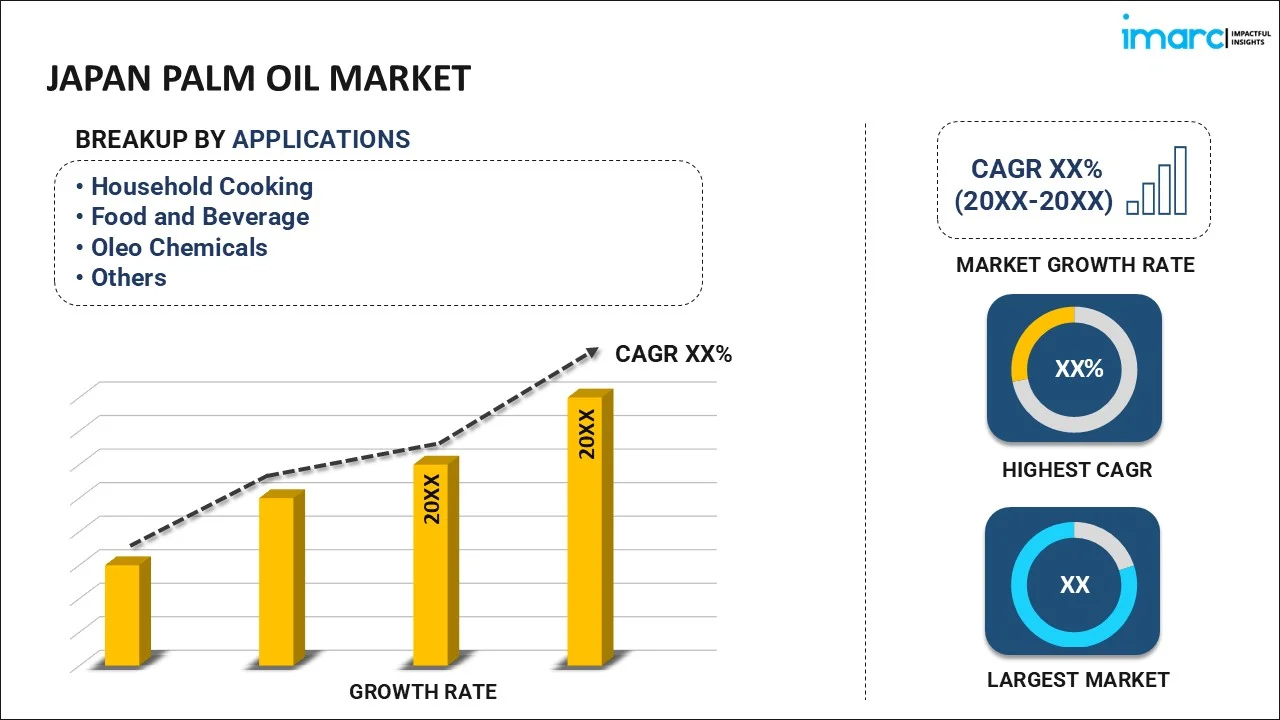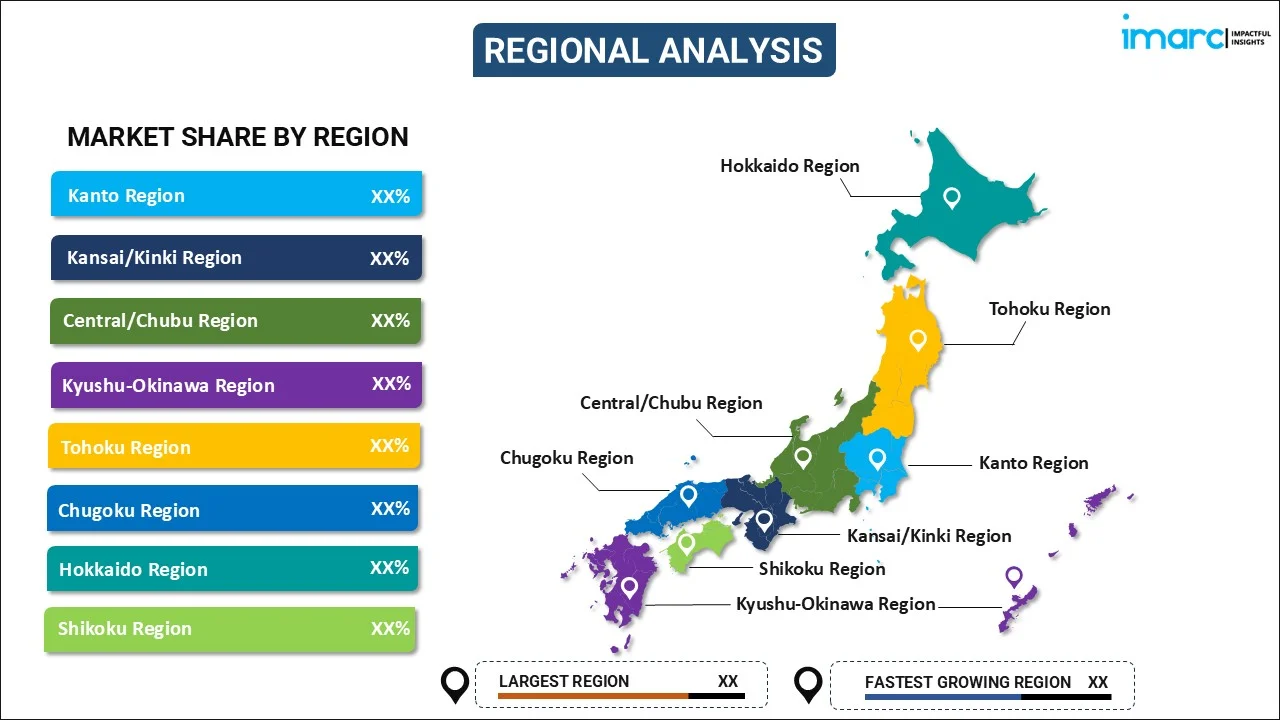
Japan Palm Oil Market Size, Share, Trends and Forecast by Application and Region, 2025-2033
Japan Palm Oil Market Overview:
The Japan palm oil market size reached USD 3.38 Billion in 2024. Looking forward, IMARC Group expects the market to reach USD 4.81 Billion by 2033, exhibiting a growth rate (CAGR) of 4.00% during 2025-2033. The market is experiencing significant growth, driven by the growing demand in food processing, biodiesel production, and cosmetics, rising consumer preference for sustainable products, increasing environmental awareness, surging use in health supplements, expanding government policies supporting renewable energy (RE), widespread availability of imports from Southeast Asia, and increasing cost-effectiveness in industrial applications.
|
Report Attribute
|
Key Statistics
|
|---|---|
|
Base Year
|
2024 |
|
Forecast Years
|
2025-2033
|
|
Historical Years
|
2019-2024
|
| Market Size in 2024 | USD 3.38 Billion |
| Market Forecast in 2033 | USD 4.81 Billion |
| Market Growth Rate (2025-2033) | 4.00% |
Japan Palm Oil Market Trends:
Growing Demand for Sustainable Palm Oil
The growing demand for sustainable palm oil is significantly enhancing the Japan palm oil market outlook. This is driven by the increased consumer awareness about environmental impacts in the region. The industry also demands authentic palm oil sourcing standards from suppliers as sustainability is a priority for both customers and businesses. Moreover, businesses have implemented Roundtable Sustainable Palm Oil (RSPO) certification standards to create a growing interest in sustainable palm oil products among consumers. For instance, RSPO operates as a worldwide voluntary network exceeding 6,000 participants who connect each segment of palm oil production to advance sustainable palm oil development. Besides this, people in Japan are willing to spend more money on sustainable products in the food and cosmetics sectors. Furthermore, government policies promote renewable resource adoption by creating a business environment that drives sustainable practice implementation. The market demand for sustainable palm oil in Japan is rising because consumer knowledge expansion enables market development to fulfill international sustainability standards.
Palm Oil in Biodiesel Production
The integration of palm oil in the production of biodiesel is driving the Japan palm oil market growth, driven by the growing emphasis of the region on RE sources. The use of palm oil biodiesel has become a vital biofuel production approach as the region works to reduce its carbon footprint and shift away from conventional petroleum products. The market demand for biofuels based on palm oil has further increased because of the introduction of RE incentives along with tax benefits by the Japanese government. For example, in 2023, the Japanese Ministry of Economy, Trade, and Industry (METI) announced to introduction of new biomass fuels alongside sustainability certificates into their Feed-in-Premium (FiP) and Feed-in-Tariff (FiT) programs. In line with this, the production of biodiesel using palm oil stands as an appealing substitute because it delivers high energy output at cost-efficient levels. Besides this, greenhouse emission reduction initiatives from Japan along with investments in renewable infrastructure create conditions that drive palm oil biodiesel adoption across the country. As a result, palm oil consumption in biodiesel consumption is expanding, as the worldwide transition toward RE continues with backing from progressive policies and improved biofuel technology.
Expansion of Palm Oil Use in Cosmetics
In Japan, palm oil is increasingly being used in cosmetics and personal care products due to its beneficial properties, such as moisturization, emulsification, and skin health. The expansion of natural and organic beauty products has resulted in palm oil becoming a fundamental cosmetic element. Japanese consumers who prioritize their skincare alongside beauty needs now select specific cosmetic ingredients that they want to see clearly stated alongside their sustainable sourcing practices. In confluence with this, the cosmetic industry in Japan actively employs sustainably obtained palm oil to align with customer demands. For instance, in 2023, Shiseido maintained a commitment to No Deforestation, No Peat, No Exploitation (NDPE) principles for palm oil procurement, which promoted No Deforestation and eliminated peat exploitation through its supply chain. Moreover, the cosmetic industry prefers palm oil because of its versatility in creating soaps, lotions, and shampoos, offering cost-saving benefits. Furthermore, the increasing environmental concerns about palm oil have directed manufacturers toward sustainable supplier certification. This trend is likely to continue, with consumer preferences pushing for greater transparency and eco-conscious production, thereby strengthening the Japan palm oil market share.
Japan Palm Oil Market Segmentation:
IMARC Group provides an analysis of the key trends in each segment of the market, along with forecasts at the region level for 2025-2033. Our report has categorized the market based on application.
Application Insights:

- Household Cooking
- Food and Beverage
- Oleo Chemicals
- Personal Care
- Animal Feed
- Bio-Fuel
The report has provided a detailed breakup and analysis of the market based on the application. This includes household cooking, food and beverage, oleo chemicals, personal care, animal feed, and bio-fuel.
Regional Insights:

- Kanto Region
- Kansai/Kinki Region
- Central/Chubu Region
- Kyushu-Okinawa Region
- Tohoku Region
- Chugoku Region
- Hokkaido Region
- Shikoku Region
The report has also provided a comprehensive analysis of all the major regional markets, which include the Kanto Region, Kansai/Kinki Region, Central/Chubu Region, Kyushu-Okinawa Region, Tohoku Region, Chugoku Region, Hokkaido Region, and Shikoku Region.
Competitive Landscape:
The market research report has also provided a comprehensive analysis of the competitive landscape. Competitive analysis such as market structure, key player positioning, top winning strategies, competitive dashboard, and company evaluation quadrant has been covered in the report. Also, detailed profiles of all major companies have been provided.
Japan Palm Oil Market News:
- In December 2024, Nissin Foods Holdings, a major palm oil buyer in Japan, pledged to build a traceable and sustainable palm oil supply chain. The company aims to collaborate with small-scale farmers in Indonesia to promote sustainable agricultural practices and improve livelihoods.
- In September 2024, The Japan International Research Center for Agricultural Sciences (JIRCAS) showcased its research on oil palm recycling technology at the "Global Festa JAPAN 2024." The initiative focuses on developing high-value-added technologies for a sustainable palm industry, addressing environmental issues associated with palm oil production.
Japan Palm Oil Market Report Coverage:
| Report Features | Details |
|---|---|
| Base Year of the Analysis | 2024 |
| Historical Period | 2019-2024 |
| Forecast Period | 2025-2033 |
| Units | Billion USD |
| Scope of the Report |
Exploration of Historical Trends and Market Outlook, Industry Catalysts and Challenges, Segment-Wise Historical and Future Market Assessment:
|
| Applications Covered | Household Cooking, Food and Beverage, Oleo Chemicals, Personal Care, Animal Feed, Bio-Fuel |
| Regions Covered | Kanto Region, Kansai/Kinki Region, Central/Chubu Region, Kyushu-Okinawa Region, Tohoku Region, Chugoku Region, Hokkaido Region, Shikoku Region |
| Customization Scope | 10% Free Customization |
| Post-Sale Analyst Support | 10-12 Weeks |
| Delivery Format | PDF and Excel through Email (We can also provide the editable version of the report in PPT/Word format on special request) |
Key Questions Answered in This Report:
- How has the Japan palm oil market performed so far and how will it perform in the coming years?
- What is the breakup of the Japan palm oil market on the basis of application?
- What are the various stages in the value chain of the Japan palm oil market?
- What are the key driving factors and challenges in the Japan palm oil market?
- What is the structure of the Japan palm oil market and who are the key players?
- What is the degree of competition in the Japan palm oil market?
Key Benefits for Stakeholders:
- IMARC’s industry report offers a comprehensive quantitative analysis of various market segments, historical and current market trends, market forecasts, and dynamics of the Japan palm oil market from 2019-2033.
- The research report provides the latest information on the market drivers, challenges, and opportunities in the Japan palm oil market.
- Porter's five forces analysis assist stakeholders in assessing the impact of new entrants, competitive rivalry, supplier power, buyer power, and the threat of substitution. It helps stakeholders to analyze the level of competition within the Japan palm oil industry and its attractiveness.
- Competitive landscape allows stakeholders to understand their competitive environment and provides an insight into the current positions of key players in the market.
Need more help?
- Speak to our experienced analysts for insights on the current market scenarios.
- Include additional segments and countries to customize the report as per your requirement.
- Gain an unparalleled competitive advantage in your domain by understanding how to utilize the report and positively impacting your operations and revenue.
- For further assistance, please connect with our analysts.
 Inquire Before Buying
Inquire Before Buying
 Speak to an Analyst
Speak to an Analyst
 Request Brochure
Request Brochure
 Request Customization
Request Customization




.webp)




.webp)












